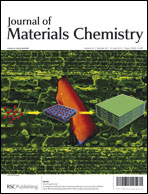Metal amidoborane ammoniates are a new type of promising hydrogen storage material consisting of metal cation, [NH2BH3]− anionic unit and NH3 ligand. Herein, we report a new reactive ball milling approach for preparation of magnesium amidoborane ammoniate, Mg(NH2BH3)2(NH3)3. Our study found that mechanically milling the NH3BH3–MgH2 mixture in a 2 : 1 molar ratio under NH3 atmosphere can readily produce Mg(NH2BH3)2(NH3)3. Its crystal structure was successfully determined by a combination of X-ray diffraction (XRD) analysis and first-principles calculations. This compound possesses a novel ordered structure with alternating layers of Mg(NH3)62+ hexamminemagnesium cations and Mg(NH2BH3)42− complex anions, in which Mg2+ exhibits both VI and IV coordinations. Property measurements found that Mg(NH2BH3)2(NH3)3 can release 7 equivalents (10.6 wt%) of H2 upon heating to 300 °C in a closed system. A combination of XRD, Fourier transformation infrared spectroscopy (FTIR), and solid-state 11B MAS NMR techniques has been employed to characterize Mg(NH2BH3)2(NH3)3 and its dehydrogenation product. A series of control experiments have also been conducted to gain insight into the formation mechanism of Mg(NH2BH3)2(NH3)3.

You have access to this article
 Please wait while we load your content...
Something went wrong. Try again?
Please wait while we load your content...
Something went wrong. Try again?


 Please wait while we load your content...
Please wait while we load your content...